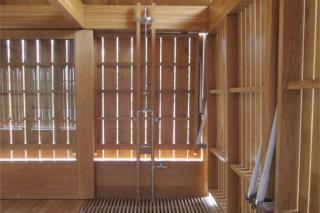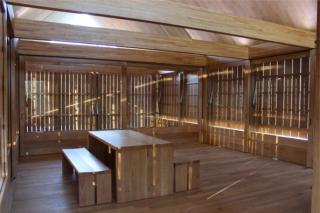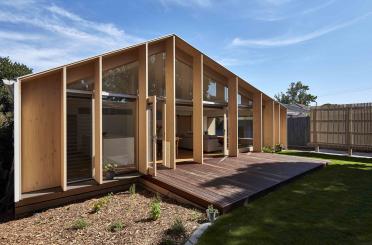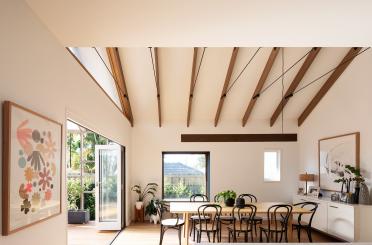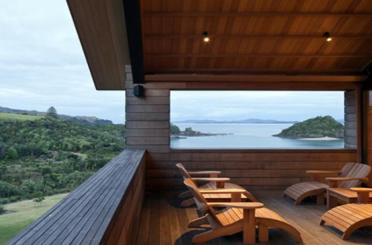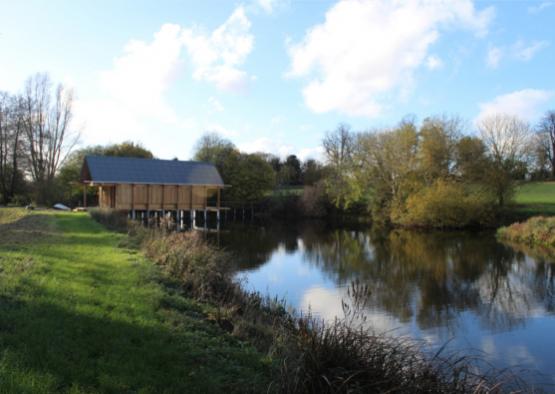
Overview
The Fishing Hut is part of the architect’s master plan for a small residential estate in Hampshire, and it sits on a man-made lake originally built as a fish farm. A river that defines its southern boundary is typical of the chalk streams running through the area: shallow, fast flowing and unpolluted. The lake provides some of the best fly-fishing in the UK.
The client wanted a secure facility in which to store boats and fishing tackle that could also function as a meeting place and shelter for anglers during the trout fishing season.
To facilitate moving boats in and out of the water, a covered mooring was required. The structure was to be as open as possible when in use to maximise views of the rural landscape in which it was situated. At the same time it had to be possible to close up and secure the building when not occupied.
The finished building projects into a small lake on galvanised supports. Its simple form and construction are familiar to rural or agricultural settings, but the level of craft and the quality materials used elevate it beyond purely functional.
European oak from France and Douglas fir from southern England are the primary timber species.
Story courtesy of Tony Neilson, former publisher of timber+DESIGN magazine.
Structure
The building is supported on eighteen pad foundations formed from precast concrete drainage rings placed on the lakebed at 1.8 m centres and filled with concrete. Nine galvanized steel goalpost frames are fixed to the pad foundations supporting the timber floor structure and glulam oak superstructure.
The roof is made of softwood rafters, clad internally with oak boards and externally with profiled aluminium sheeting on larch battens. The building’s structure organises its plan into 10 bays of 1.8 m. A pair of bays at each end form open decks, partly covered by the overhanging pitched roof.
Below the eaves, shutters and cladding formed of open jointed timber planks enclose the six central bays. This enclosure comprises a weather tight internal space of four bays and a semi-enclosed storage area.
The project site is of significant ecological importance at national and European level. The riverine environment is designated as an SSSI (Special Site of Scientific Interest) and an SAC (Special Area of Conservation). The design considers its impact on the wider environment through the use of materials selected for their inherent durability for each specific component to maximise life expectancy, limit maintenance and minimise embodied energy.
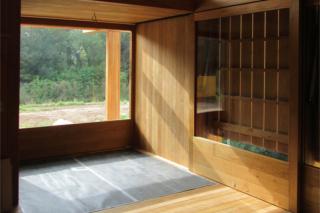
Exterior
Intermittent use of the building provided the starting point for the design: completely open to the elements when in use, but secure and weatherproof for the rest of the year. That was achieved with a facade of timber shutters that fold up to allow views right through the interior.
The shutters are horizontally pivoted upward from the eaves, making the enclosure disappear and leaving you on a deck above the water beneath the pitched roof. The architects selected a product that offered the smallest visual intrusion on the continuous horizon.
When closed, the pitched roof and handling of the cladding refers directly to the construction of modern agricultural buildings. Oak was chosen for the exposed timber structure and cladding due to its colour and grain.
The untreated exterior timber will weather to match the silver-grey of the roof cladding and steel supports.
The site is of significant ecological importance at a national and European level. The riverine environment is designated as an SSSI and SAC. All of the timber used for the project is FSC or PEFC certified.
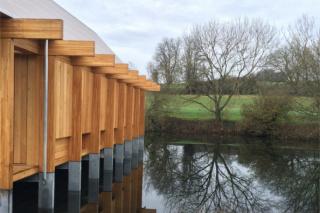
Interior
In plan, the cabin is divided up into 10 bays that each measure 1.8 m wide. Some are enclosed, while others form open decks sheltered beneath the overhanging eaves.
A loft provides storage spaces for boats, freeing up the main floor to accommodate a kitchen and dining space, a small reception space and a toilet. There is also an external shower and a covered mooring.
Below the eaves, shutters and cladding formed of open-jointed timber planks enclose six weather-tight central bays.
In contrast to the exterior, the timber of the enclosed interior will retain its warm golden tone, which is revealed and reflected in the water as the perimeter shutters are opened.
The Fishing Hut was completed in late 2014 and has since won the RIBA Stephen Lawrence Prize 2015 and the Arnold Laver Gold Award in the 2015 UK Wood Awards.
